
Mack Sennett was a Canadian-American producer, director, actor, and studio head who was known as the "King of Comedy" during his career.

Gloria Josephine Mae Swanson was an American actress. She first achieved fame acting in dozens of silent films in the 1920s and was nominated three times for the Academy Award for Best Actress, most famously for her 1950 turn in Billy Wilder's Sunset Boulevard, which also earned her a Golden Globe Award.

The Essanay Film Manufacturing Company was an early American motion picture studio. The studio was founded in 1907 in Chicago, and later developed an additional film lot in Niles Canyon, California. Its various stars included Francis X. Bushman, Gloria Swanson and studio co-owner, actor and director, Broncho Billy Anderson. It is probably best known today for its series of Charlie Chaplin comedies from 1915-1916. In late 1916, it merged distribution with other studios and stopped issuing films in the fall of 1918. According to film historian Steve Massa, Essanay is one of the important early studios, with comedies as a particular strength. Its founders, George Kirke Spoor and Anderson, were subsequently awarded special Academy Awards for pioneering contributions to film.
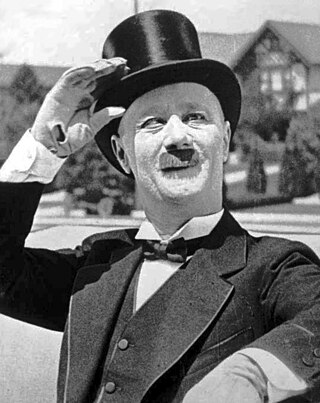
Bernard "Ben" Turpin was an American comedian and actor, best remembered for his work in silent films. His trademarks were his cross-eyed appearance and adeptness at vigorous physical comedy. A sometimes vaudeville performer, he was "discovered" for film while working as the janitor for Essanay Studios in Chicago. Turpin went on to work with notable performers such as Charlie Chaplin and Laurel and Hardy, and was a part of the Mack Sennett studio team. He is believed to have been the first filmed "victim" of the pie in the face gag. When sound came to films, Turpin chose to retire, having invested profitably in real estate, although he did do occasional cameos.

Olga Edna Purviance was an American actress of the silent film era. She was the leading lady in many of Charlie Chaplin's early films and in a span of eight years, she appeared in over 30 films with him. Her name was pronounced "pur-VIE-unce" as verified by Chaplin in his spoken narration of one of his films.
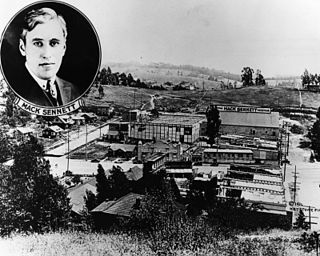
Keystone Studios was an early film studio founded in Edendale, California on July 4, 1912 as the Keystone Pictures Studio by Mack Sennett with backing from actor-writer Adam Kessel (1866–1946) and Charles O. Baumann (1874–1931), owners of the New York Motion Picture Company. The company, referred to at its office as The Keystone Film Company, filmed in and around Glendale and Silver Lake, Los Angeles for several years, and its films were distributed by the Mutual Film Corporation between 1912 and 1915. The Keystone film brand declined rapidly after Sennett went independent in 1917.
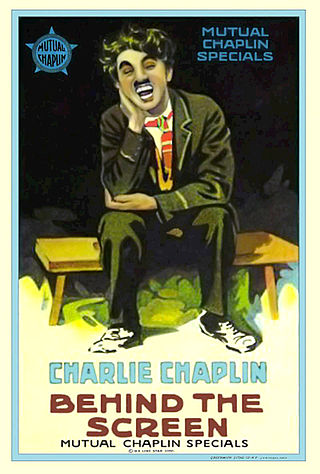
Behind the Screen is a 1916 American silent short comedy film written by, directed by, and starring Charlie Chaplin, and also starring Eric Campbell and Edna Purviance. The film is in the public domain.
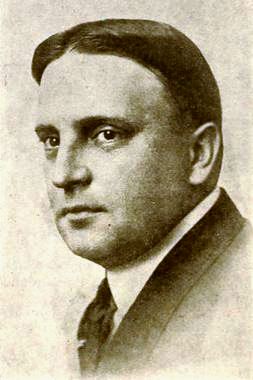
George Kirke Spoor was an early film pioneer who, with Gilbert M. "Broncho Billy" Anderson, founded Essanay Studios in Chicago in 1907. He was a founding partner of V-L-S-E, Incorporated, a film distribution firm, in 1915.
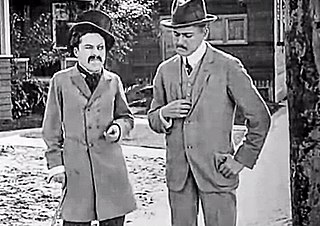
Making a Living is the first film starring Charlie Chaplin. A one-reel comedy short, it was completed in three days at Keystone Studios in Los Angeles, California and was released for distribution on February 2, 1914. In it Chaplin portrays a charming swindler who runs afoul of a news reporter and a Keystone Cop. In addition to co-writing the "scenario" and directing the production, Henry Lehrman performs as the principal supporting character.

Show People is a 1928 American synchronized sound comedy film directed by King Vidor. While the film has no audible dialog, it was released with a synchronized musical score with sound effects using both the sound-on-disc and sound-on-film process. The film was a starring vehicle for actress Marion Davies and actor William Haines and included notable cameo appearances by many of the film personalities of the day, including stars Charlie Chaplin, Douglas Fairbanks, William S. Hart and John Gilbert, and writer Elinor Glyn. Vidor also appears in a cameo as himself, as does Davies.
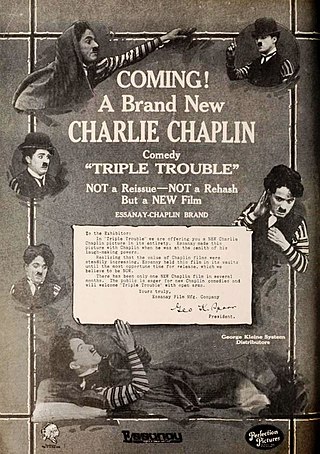
Triple Trouble is a two-reel American silent comedy film that was released in 1918. It stars Charlie Chaplin, Edna Purviance, and Leo White. This film was not an official Chaplin film, even though it has many Chaplin-directed scenes; after he left the studio, Essanay edited it together using outtakes and newly shot footage directed by Leo White. It had already been established in court that Chaplin had no legal control over the films made during his time with Essanay and could not prevent its release.

Chester Cooper Conklin was an early American film comedian who started at Keystone Studios as one of Mack Sennett’s Keystone Cops, often paired with Mack Swain. He appeared in a series of films with Mabel Normand and worked closely with Charlie Chaplin, both in silent and sound films.
Edendale is a historical name for a district in Los Angeles, California, northwest of Downtown Los Angeles, in what is known today as Echo Park, Los Feliz and Silver Lake. In the opening decades of the 20th century, in the era of silent movies, Edendale was known as the home of most major movie studios on the West Coast. Among its many claims, it was home to the Keystone Cops, and the site of many movie firsts, including Charlie Chaplin's first movie, the first feature-length comedy, and the first pie-in-the-face. The Edendale movie studios were mostly concentrated in a four-block stretch of Allesandro Street, between Berkeley Avenue and Duane Street. Allesandro Street was later renamed Glendale Boulevard.

His New Profession is a 1914 American comedy silent film made at the Keystone Studios and starring Charlie Chaplin. The film involves Chaplin taking care of a man in a wheelchair. It is also known as "The Good for Nothing".
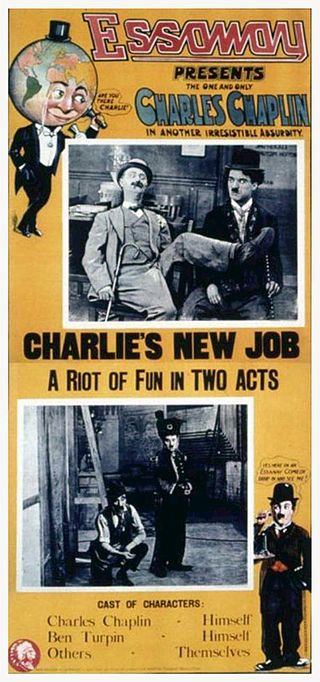
The Chicago film industry is a central hub for motion picture production and exhibition that was established before Hollywood became the undisputed capital of film making. In the early 1900s, Chicago boasted the greatest number of production companies and filmmakers. Essanay Studios founded by George K. Spoor was one of the earliest successful studios to produce movies in Chicago, employing stars such as Charlie Chaplin and Gloria Swanson. Actor and co-founder of Essanay Studios, Broncho Billy Anderson gave birth to the western genre. Early film companies such as Essanay Studios produced multiple silent films every week and rented viewing equipment to showcase the latest cinematography to the public. This rental culture gave birth to the popularity of Nickelodeons up until the Great Depression. However, due to the high demand for motion pictures during this time, a black market for films and equipment developed. The Motion Picture Patents Company, established in 1909 as a conglomerate of the major studios, sought to eliminate all illegal use of patented film equipment. As a result, independent ventures entered the film scene. Independents drove the film industry to the west to avoid legal trouble with the trust of major film companies united under the Motion Picture Patents Company. The west offered fairer weather and scenery that better accommodated film making. Not until the 1980s and early 21st century has Chicago experienced a film production revival. Blockbusters, such as Blues Brothers, Sixteen Candles, and The Dark Knight, have rejuvenated the Chicago film scene.

(Sir) Charlie Chaplin (KBE) (1889–1977) was an English internationally renowned Academy Award-winning actor, comedian, filmmaker and composer who was best known for his career in Hollywood motion pictures from his debut in 1914 until 1952; he however subsequently appeared in two films in his native England. During his early years in the era of silent film, he rose to prominence as a worldwide cinematic idol renowned for his tramp persona. In the 1910s and 1920s, he was considered the most famous person on the planet.

A Film Johnnie is a 1914 American-made motion picture starring Charles Chaplin, Roscoe Arbuckle, and Mabel Normand.

Tango Tangles is a 1914 American film comedy short starring Charles Chaplin and Roscoe Arbuckle. The action takes place in a dance hall, with a drunken Chaplin, Ford Sterling, and the huge, menacing, and acrobatic Arbuckle fighting over a girl. The supporting cast also features Chester Conklin and Minta Durfee. The picture was written, directed and produced by Mack Sennett for Keystone Studios and distributed by Mutual Film Corporation.

A Thief Catcher is a one-reel 1914 American comedy film, produced by Mack Sennett for his Keystone film company, directed by Ford Sterling, and starring Sterling, Mack Swain, Edgar Kennedy, and Charles Chaplin as a Keystone Cop.
Charles Jacob Stine was an American silent film actor.


















